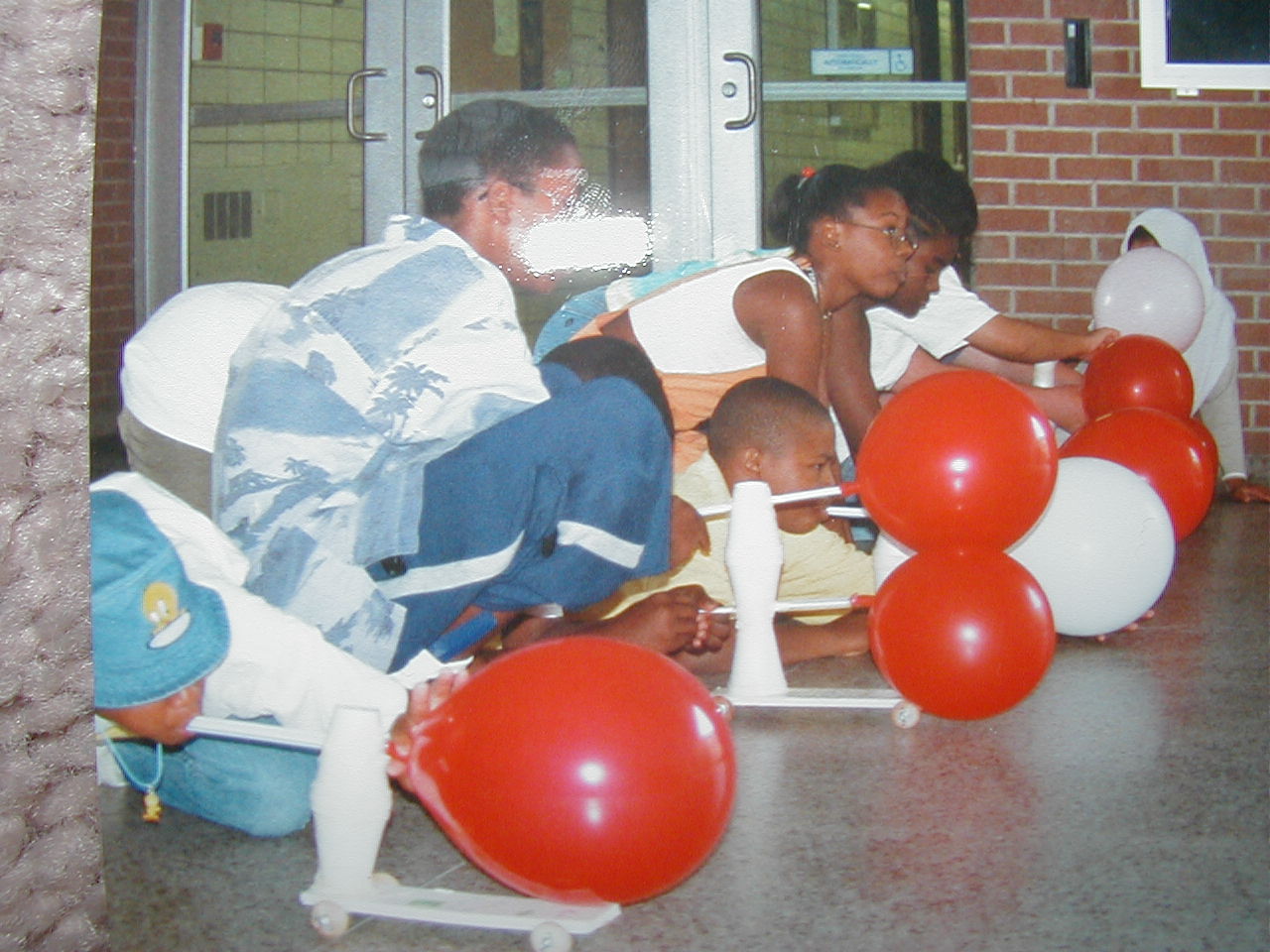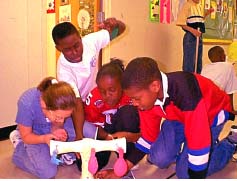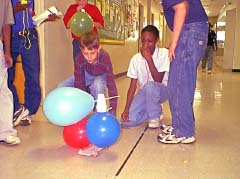 The Balloon Car Mini-Challenge challenges students to create the very best balloon-powered propulsion system they can for their vehicles. It should make the vehicle go as far and straight as possible. This challenge gives students more experience with combining forces, introduces speed and velocity, mass and weight, acceleration, and introduces Newton's Second and Third Laws of Motion.
The Balloon Car Mini-Challenge challenges students to create the very best balloon-powered propulsion system they can for their vehicles. It should make the vehicle go as far and straight as possible. This challenge gives students more experience with combining forces, introduces speed and velocity, mass and weight, acceleration, and introduces Newton's Second and Third Laws of Motion.
They begin by messing about with balloon propulsion. They build several balloon-straw systems - some with shorter straws, some with longer; some with bigger balloons, some with smaller; some with wider straws, some with narrower ones. They try out a few and look at what seems to make a difference, then continue by gathering around a new whiteboard, this time writing down what they know about getting things going, the ideas they have about the best balloon-powered systems, and questions they need to answer to be able to address the balloon-car challenge well. Questions raised here are about the optimal lengths and widths of straws, the optimal size of balloons, the number of balloons, and the number of balloon engines.
Each group chooses one question and designs and runs an experiment to find its answer. For example, if the students wanted to find out what size of balloon would propel a car the furthest, they would run five tests each on three different sized balloons using the same size straw and the same car. Students should take care during this exercise to ensure that their measurements and tests are accurate and fair.
One way to judge if an experiment's results are trustworthy is to try to generate a design rules of thumb from the findings. When findings are consistent, this is not hard. For example, if the largest balloon consistently made the car go farther than the other balloons and the smallest balloon consistently made it go least far, it is easy to generate a rule of thumb: "Larger balloons will make a balloon-powered vehicle go farther." But if results are not consistent, it usually means that some variable was not controlled well and the no rule of thumb can be derived.
During a poster session, students present their experimental results to each other. Because students need each others' results in order to design their best balloon engine, they listen intently to each others' presentations, trying to discern if the experiment was designed and run well enough so that they can believe its results. Students question each other about their procedures and results, helping each other see any sloppiness in their experimental procedures. If students feel they can't trust the results of a group's experiment, they help them redesign it and send them back to run it again.
 The class compiles a list of rules of thumb that they can derive from the experiments that have been run. These early rules of thumb are not very sophisticated. In fact, they are almost always missing explanations, and they are often incomplete or inaccurate. But we shall see that they provide a way of motivating a need to learn the science.
The class compiles a list of rules of thumb that they can derive from the experiments that have been run. These early rules of thumb are not very sophisticated. In fact, they are almost always missing explanations, and they are often incomplete or inaccurate. But we shall see that they provide a way of motivating a need to learn the science.
When students are satisfied that questions are answered well, they use the results of experiments and the design rules of thumb generated to design their best balloon-powered vehicle. For homework, each student does this individually. In class the next day, groups piece together the best features of everyone's individual designs and decide how they will build their group's car. Each feature they decide on must be justified with evidence - from an experiment, a rule of thumb, or scientific concepts the students know well. They sketch and label their designs so that they can be easily understood by students outside their group.
Next, they present their design ideas to the class in a "pin-up session." Students share their design decisions and why they made each, and they predict how their cars will perform. This is different from a gallery walk in that they're sharing ideas rather than results (they don't have any results to show yet). The pin-up session serves as an opportunity for the groups to give advice to each other and help groups making less progress to catch up with groups that are further along.
 Groups proceed to build the balloon-powered propulsion systems they designed, and they test them. As with their first coaster cars, their first balloon-car engines almost never perform as they want them to. Again, they present their first try to each other in a gallery walk. They ask each other for advice in doing better, and issues of combining forces come to the fore. The teacher points them to pages to read in the textbook, and they have discussions about the forces involved in getting their cars going. The class also reviews fair ways of getting cars started and measuring their distance traveled.
Groups proceed to build the balloon-powered propulsion systems they designed, and they test them. As with their first coaster cars, their first balloon-car engines almost never perform as they want them to. Again, they present their first try to each other in a gallery walk. They ask each other for advice in doing better, and issues of combining forces come to the fore. The teacher points them to pages to read in the textbook, and they have discussions about the forces involved in getting their cars going. The class also reviews fair ways of getting cars started and measuring their distance traveled.
Students attempt another iteration, taking into account what they've learned about combining forces. Another gallery walk is held, and other scientific concepts are chosen for discussion - perhaps speed and velocity or acceleration. Discussion begun during the Coaster Car Challenge about how additional force makes cars go farther is continued, and students begin to piece together the way additional force contributes to more acceleration which contributes to greater speeds which contributes to greater distances.
After several more iterations and discussions, a contest is held to see whose balloon-powered car can go the farthest. Students compare and contrast the different designs to learn more about how forces combine.
Students also engage in three more activities with their balloon cars - a balloon-car tug-of-war to experience opposing forces; a balloon-car weight-pulling activity, in which they see how much mass they can add to their cars before they won't get started; and an activity where they see if their balloon-powered vehicles can make it over the test track (the two hills). The weight-pull activity is designed to help students see that more mass requires more force for acceleration. Trying out their vehicles on the test track shows them that they aren't finished yet. While they know some things about effects of increasing force and of decreasing mass, their vehicles still can't go over the hills.
Upon completion, students return to the original whiteboard. Questions they raised early on about getting things moving can now be answered, and they update the "facts" section of the whiteboard. They also refine their ideas for their final vehicle. And they revise the questions on the whiteboard. If they didn't have questions previously about getting cars over hills, they add them. Now, however, the teacher requires that the questions be in the language of forces. While earlier, a question like, "How can we get the cars to go over hills?" would have been fine, students now know enough about getting things moving to be able to ask the question in a more scientific way. They revise the questions on the whiteboard using their new conceptions and vocabulary. The question above might be transformed into, "What kind of engine will provide enough force early on to accelerate the car enough so that it will go over the hill?" After review of their practices and the LBD™ cycle, students are ready to go on to the next mini-challenge.
|

